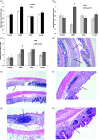Bisphenol-A alters microbiota metabolites derived from aromatic amino acids and worsens disease activity during colitis
- PMID: 29874946
- PMCID: PMC6022909
- DOI: 10.1177/1535370218782139
Bisphenol-A alters microbiota metabolites derived from aromatic amino acids and worsens disease activity during colitis
Abstract
Inflammatory bowel disease is a complex collection of disorders. Microbial dysbiosis as well as exposure to toxins including xenoestrogens are thought to be risk factors for inflammatory bowel disease development and relapse. Bisphenol-A has been shown to exert estrogenic activity in the colon and alter intestinal function, but the role that xenoestrogens, such as bisphenol-A , play in colonic inflammation has been previously described but with conflicting results. We investigated the ability of bisphenol-A to exacerbate colonic inflammation and alter microbiota metabolites derived from aromatic amino acids in an acute dextran sulfate sodium-induced colitis model. Female C57BL/6 mice were ovariectomized and exposed to bisphenol-A daily for 15 days. Disease activity measures include body weight, fecal consistency, and rectal bleeding. Colons were scored for inflammation, injury, and nodularity. Alterations in the levels of microbiota metabolites derived from aromatic amino acids known to reflect phenotypic changes in the gut microbiome were analyzed. Bisphenol-A exposure increased mortality and worsened disease activity as well as inflammation and nodularity scores in the middle colon region following dextran sulfate sodium exposure. Unique patterns of metabolites were associated with bisphenol-A consumption. Regardless of dextran sulfate sodium treatment, bisphenol-A reduced levels of tryptophan and several metabolites associated with decreased inflammation in the colon. This is the first study to show that bisphenol-A treatment alone can reduce microbiota metabolites derived from aromatic amino acids in the colon which may be associated with increased colonic inflammation and inflammatory bowel disease. Impact statement As rates of inflammatory bowel disease rise, discovery of the mechanisms related to the development of these conditions is important. Environmental exposure is hypothesized to play a role in etiology of the disease, as are alterations in the gut microbiome and the metabolites they produce. This study is the first to show that bisphenol-A alone alters tryptophan and microbiota metabolites derived from aromatic amino acids in a manner consistent with autoimmune diseases, specifically inflammatory bowel diseases, regardless of dextran sulfate sodium treatment. These findings indicate a potential mechanism by which bisphenol-A negatively affects gut physiology to exacerbate inflammation.
Keywords: Bisphenol-A; colitis; inflammatory bowel disease; microbiota metabolites; tryptophan; xenoestrogen.
Figures







References
-
- Martin T, Chan S, Hart A. Environmental factors in the relapse and recurrence of inflammatory bowel disease: a review of the literature. Dig Dis Sci 2015; 60:1396–405 - PubMed
-
- Loftus E, MacIntosh D, Fardy J, Simms L, Sandoval J, Hermon TJ, Rhodes G, Pickup R, Hermon TJ, Ward J, Marcy S, Eriksen E, Destefano F, Chen R, Morettini A. Clinical epidemiology of inflammatory bowel disease: incidence, prevalence, and environmental influences. Gastroenterology 2004; 126:1504–17 - PubMed
-
- Michałowicz J. Bisphenol A – sources, toxicity and biotransformation. Environ Toxicol Pharmacol 2014; 37:738–58 - PubMed
Publication types
MeSH terms
Substances
Grants and funding
LinkOut - more resources
Full Text Sources
Other Literature Sources
Molecular Biology Databases
Research Materials

